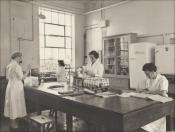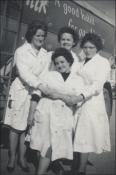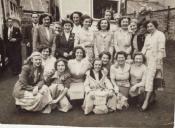Browse the interviews
Sorted by interviewee name
VSE050 Audrey Gray, Johnson & Johnson, Pengam;British Nylon Spinners, Pontypool
Audrey left the grammar school (she describes her experiences in detail) at 17 (1953/4) and though destined for university her brothersŌĆÖ weddings left her mother with no income and she went to work in the laboratory in BNS, testing yarns for viscosity etc. Keeping records and cleaning everything in the evening. Notes working with asbestos baths and fume cupboards when describing processes. Tested raw materials too e.g. water and coal. Girls didnŌĆÖt work on the night shift. She understood the production process. She notes that girlsŌĆÖ schools didnŌĆÖt have chemistry labs. Number of toxic and dangerous chemicals. Wore terylene lab coats, two strength gloves ŌĆō gauntlets of rubber, eye-shields compulsory for some jobs, She had one accident - a flask bubbled up and shot solution into her face ŌĆō first aiders, nurses and hospital. One walk out because hot and air conditioning not working. Social life with lab people mainly. Different clubs ŌĆō tennis, table tennis, canoeing. Beautiful factory grounds. Laundry basket for their lab coats, dusters etc. Paid monthly. They were given shares and pensions. Seven day shift system. She belonged to the ASTMS union- Assoc. of Technical and Management ? With automation came redundancies. She describes the excellent social club and events. Xmas dances ŌĆō responsibility of one shift, like a film set. She stayed there for 12-3 years and then to JohnsonŌĆÖs in the quality control lab for a few years. It produced j cloths.

VSW009 Helena Gregson, Slimma-Dewhirst, Lampeter
Helena left school at 15 in 1970. She used to sew for the family. She went straight to Slimma's and stayed 32 years (2002). She had a machine test. She earned ┬Ż10 a week. She remembers the noise of the machines, piece-work, targets and tickets, the clothes went to M&S. It was a ŌĆśgood schoolŌĆÖ- she was flexible as a floater. There was a Social Club there. She left to have her first child (1982) and returned part time. She went to London to train as supervisor. She became a shop steward. Some girls wore rollers to work. Accidents with the needles. One girl's hair went into the machine. Guessing the names of songs on the radio - Golden Oldies. At Xmas there was turkey and champagne as bonus. They had seconds. Some of the women played football and they had a Slimma Queen. She set up her own sewing business after leaving. The factory moved to Morocco. There was great sadness at this.Part of this interview is available as an audio file
VN033 Mair Griffiths, Langefni Milk Factory, Llangefni
Mair was a farmer's daughter, one of seven children, though the farm was sold after his death. Some of her sisters worked in a sewing factory. She left school at 16 to look for work, as coming from a large family it was necessary. She had wanted to be a nurse but she would have had to wait until she reached 19. She learned to type in the British School while looking for a job, and eventually got one in the milk factory, although she tried for work in the sewing factory too. This was in 1949 and she learned how to test the milk on the job. The relationship between the workers was good. ┬Ż1 12 and 6 was her first wage and she gave most of it to her mother. She lived in Bodffordd and went to work on the bus. In the beginning she worked 9-5 but it didn't seem like a long day. Later on she did nightshifts too and bought a bike to travel to work then. There wasn't a canteen there just a little cwtsh where they used to hang their coats. There wasn't even a kettle and they used to boil water for tea in the lab. Mair worked there for 17 years until she lost her job in 1966 during a milk shortage, being a married woman with a husband to support her. It was supposed to be first in last out, she said, but not in her case. She was out of work for a while and it was awful, she said, signing on the dole, until she got another job.

VSE077 Jeanette Groves, Western Shirt Company, Cardiff
Jeanette left school at 14 (1946) and started in the sewing factory, where her mother used to work. She started in the cutting room then she became a machinist. Needles through fingers, scissors in her eye and one woman scalped (in her motherŌĆÖs time) Getting to work by bus or bike. Wearing rollers to work but putting make up and combing hair at the first break. Some made their own clothes during lunch time. Had to unpick if there was a mistake and they helped one another or lose money. Their aim was a dozen skirts an hour @ 1shilling a dozen. Out around Cardiff during lunch break. A crowd went out in the evenings ŌĆō dancing. They waited for natural light before making dark clothing. They made shirts and pyjamas only. Teasing the one mechanic by interfering with their machines. Annual trips and issued with cigarettes. She left after 3 years because she had TB. She married and moved to Bristol where it was cured eventually.
VN048 Olive Jones and Marilyn Hankin, Graessers Salicylates, Sandycroft;Shotton Steam Laundry, Shotton;Sandycroft Dry Cleaners, Sandycroft
Olive worked in the laundry straight from school, beginning by ironing small things and then going onto bigger items like shirts, she did this the whole time she was there, 1928-1994, in total 66 years. It was an interesting job, quite varied, but could be dangerous because of the hot steam coming out of the machines. She said : ŌĆ£When I come eighty, I said thatŌĆÖs enough! And that was it, wasnŌĆÖt it? I left then.ŌĆØ Her daughter Marilyn did shop work before going into the pharmaceutical factory in 1964 where she stayed until 1970 packing aspirins and other drugs. She said : ŌĆ£It was something you had to do, and you worked to live. You worked so you could live, and look forward to your week ends. While you were in work it was ok. You work with a lot of women your own age, but as soon as you come home, you left work at work, it was your home life then. Once you finished at five oŌĆÖclock that was it until the next day.ŌĆØ She left after five years to become a house wife and raise her children.VSW040 Ann Harrison, Mettoys, Fforestfach
Ann attended Technical School to learn to type and was employed to work in the office at Mettoys. But she thought the office girls were better than her so she moved to the shop floor. She made James Bond cars. She had spina bifida but could walk around. Her mother worked there too and tried to protect her from the crude jokes. Piecework and helping one another. She married in 1967.VSW033 Margaret Hayes, Mettoys, Swansea
Margaret left school ay 14 (1937) and worked in shops and as an usherette until called up during the war. She began in Mettoys making marvellous toys out of cast iron in the 1950s. She worked in the warehouse on the evening shift but was also keeping house for a family of eight. The workers could buy a big bag of toys for ┬Ż5. She claims that Welsh speakers would be punished if they spoke Welsh. Rats in the warehouse. Mettoys ŌĆśappreciatedŌĆÖ its workers. She left in c.1973. ŌĆśRaucousŌĆÖ jokes. No accidents though there was red hot plastic coming out of hoppers. Remembers hearing the news of Aberfan disaster. Did work on factory floor too. Families worked together. Downs Syndrome girl worked there on lighter work. Never shy after working in a factory.VSE029 Patricia Howard, Harwin's Electronics Factory, Treorchy;Ray-O-Vac battery factory, Treorchy;Winchester Sausage Factory, Treorchy;Sobells, Aberdare;EMI, Treorchy;Polikoff's, Treorchy
PatriciaŌĆÖs father worked as collier for 51 years. She left school at 15 (1958) and started in PolikoffŌĆÖs but hated sewing. After a week (went back there later) moved to SobellŌĆÖs. ŌĆśYour life is ruled by a bell.ŌĆÖ Making televisions- putting glass fibre on sleeving, then soldering. Found canteen forbidding. Smoking at workplace. Factory work calls for self-discipline. Women did conveyor belt work. Stayed 2 years, and then to EMI ŌĆō working with a needle and gold wire. No conveyor belt. Strike because of cold. Bonus because of the Beatles. Made different parts of record players. Night out in Shack, live music. After this she and her sister went away to Winchester. Returned fairly quickly to Ray-o-vacs. Dirty because of carbon. Making batteries. Then pregnant and returned after 2 years to EMI (same firm) She was 21 now. She lived on pocket money until 29. She stayed 9 years in EMI. Suspended because of Xmas revelry but factory went on strike. Then reinstated. EMI social club. Good-natured teasing. Later she worked for HarwinŌĆÖs for 11 years, Made redundant at 53 (1996). HarwinŌĆÖs made intricate components ŌĆō again soldering. No union but well-treated. Still working in caring at 71 years old. She played for EMI football team against PolikoffŌĆÖs ŌĆō for Cambrian disaster fund (1965). They won ŌĆō ructions.VSW062 Sylvia Howell, Salter, Llanelli;John Stanton, Llanelli
Sylvia left grammar school with O Levels when she was 17. She intended becoming a nurse, but married instead. She worked in shops and at the Opticals, Cydweli but after her son was born she started in John StantonŌĆÖs as a top sewing machinist in 1967 (until c. 1969) ŌĆō quite a posh factory. They made clothes for M&S, Targets, time and motion and bonuses. Injuries with the sewing needles. There wasnŌĆÖt a union and when they tried to unskill her job she moved to the SalterŌĆÖs Factory (1969-78) -as a calibrator, making scales. She worked for the money but the company was good too. She moved to inspection in the warehouse. They bought seconds in both factories and there was some pilfering. SalterŌĆÖs closed in 1978.VSE082 Mary Patricia (Pat) Howells, Dunlop, Rhigos, Hirwaun estate;Lastex Yarn and Lactron Threads (LYLT), Rhigos, Hirwaun estate
Pat recalls her working life on the Rhigos Trading Estate and how her father was an engineer at Dunlop's on the estate. She left school at fifteen to work in Dunlop's too where she trimmed mattresses and cushions etc. She handed her pay docket over to her mum. As a family, they lived in houses built for the estate workers. The workers didn't talk, it was work, work, work. Then she moved to Lastex Yarns and Lactron Threads (LYLT) - better prospects. She became a supervisor and then a forewoman. She remembers losing the top of her finger in Dunlop's. As supervisor helped with personal problems e.g. pregnancy. They used lots of French chalk which had to be blown off their overalls every evening. One hour of radio a day. Sports and Social Club - they played netball, and did archery. Also there were plays in the canteen. There was an annual Miss Dunlop's competition. She married a miner and left the factory when she was pregnant.



